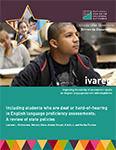Including students with low-incidence disabilities (e.g., students who are blind and students who are deaf) on all domains of an English language proficiency (ELP) assessment can be challenging. For example, how is reading in English measured for students who are blind and typically access text through braille? Similarly, how is listening in English measured for students who are deaf and usually receive information communicated orally through American Sign Language (ASL) or closed captioning? These are challenges that state departments of education have addressed through accommodations policies for ELP assessments. Two new NCEO publications address accommodations on ELP assessments.
 Including students who are blind or visually impaired in English language proficiency assessments: A review of state policies focuses on accommodations that provide access to ELP assessments for students who are blind or visually impaired. In this report, NCEO staff found that across all domains, Braille, Large Print, and Magnification Equipment appeared to be the least controversial accommodations. State policies on Read Aloud Questions varied across domains. This accommodation was generally not allowed on the Reading domain, but more than half of all states allowed its use on the Writing domain. Very few states had policies allowing Read Aloud Questions on the Listening and Speaking domains.
Including students who are blind or visually impaired in English language proficiency assessments: A review of state policies focuses on accommodations that provide access to ELP assessments for students who are blind or visually impaired. In this report, NCEO staff found that across all domains, Braille, Large Print, and Magnification Equipment appeared to be the least controversial accommodations. State policies on Read Aloud Questions varied across domains. This accommodation was generally not allowed on the Reading domain, but more than half of all states allowed its use on the Writing domain. Very few states had policies allowing Read Aloud Questions on the Listening and Speaking domains.
 Including students who are deaf or hard-of-hearing in English language proficiency assessments: A review of state policies addresses those accommodations policies that provide access for students who are deaf or hard-of-hearing. Findings from this report indicate that across all domains, Sign Interpret Directions and Amplification Equipment were the least controversial accommodations, with the majority of states allowing their use on all assessment domains. Sign Interpret Questions and Sign Response were consistently prohibited across the majority of states.
Including students who are deaf or hard-of-hearing in English language proficiency assessments: A review of state policies addresses those accommodations policies that provide access for students who are deaf or hard-of-hearing. Findings from this report indicate that across all domains, Sign Interpret Directions and Amplification Equipment were the least controversial accommodations, with the majority of states allowing their use on all assessment domains. Sign Interpret Questions and Sign Response were consistently prohibited across the majority of states.
These reports can be found on the NCEO website:
http://www.cehd.umn.edu/nceo/OnlinePubs/IVAREDBlindVIReport.pdf
http://www.cehd.umn.edu/nceo/OnlinePubs/IVAREDDeafHardofHearingReport.pdf
